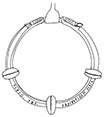The most characteristic church keys have ring-shaped bows that are divided into three distinct sections. The keys are forged of iron, and the sections consist of three narrow round bands or small forged spheres placed equidistant from each other. The pipes are forged into tubes and the key bits often feature cross shapes. The keys were used for the door locks, usually wooden block locks, that were fitted on the inside of the church door.
The same kind of three-section design with spheres is found on a large number of iron door rings or doorknockers on medieval Swedish churches. They are often combined with dragon heads where the ring is attached to the door plate.
 |
| Doorknocker in Angelstad Church in southwestern Småland. Illustration by the author. |
A key is a symbol of all forces that open and close, bind and release. It stands for liberation and incarceration. St. Peter is called the guardian of the gates of heaven, and the key or keys are his attribute. Since the 13th century, his successors to the Holy See – the popes – have had a coat of arms with two crossed keys, one silver and one gold. One of the entrances to Forshem Church in Västergötland province has a relief on the tympanum, between the lintel and arch of the door, showing Christ giving Peter the key to heaven and Paul a book. The Roman design of the key helps to determine the age of the church, which was built in the early 1100s.
Three is a sacred number in most religions and cultures. The three bands are linked to the three-leaf clover shape of the trefoil, which symbolizes the Holy Trinity of the Father, Son, and Holy Spirit in Christianity. Omne trium perfectum – everything that comes in threes is perfect – or all good things come in threes. Christianity adopted the three-leaf clover shape from the Arabic three-leaf clover called shamrakh, which represented the Persian triads, the mystical number three, and the sun wheel.
The keys to the city were symbols of the residents’ right to self-determination. If a city had to surrender to an attacking army, this was symbolized by the keys to the city being turned over to the conquerors.